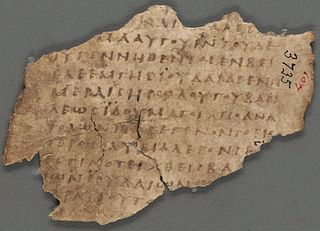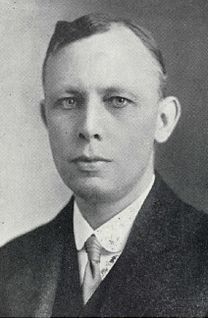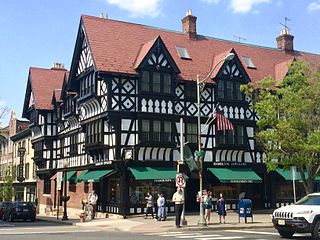
Papyrus 1 designated by "1", "ε 01 ", is an early copy of the New Testament in Greek. It is a papyrus manuscript of the Gospel of Matthew dating palaeographically to the early 3rd century. It is currently housed at the University of Pennsylvania Museum, and was discovered in Oxyrhynchus, Egypt.

Uncial 0162, ε 023, is one vellum leaf of a Codex containing The Gospel of John in Greek. It has been paleographically assigned a 3rd or 4th century CE date.
Uncial 069, ε 12 (Soden), is a Greek uncial manuscript of the New Testament, dated paleographically to the 5th century.

Uncial 071, ε 015 (Soden), is a Greek uncial manuscript of the New Testament, dated paleographically to the 5th or 6th century. It came from Oxyrhynchus.

Papyrus 5, designated by siglum 5, is an early copy of the New Testament in Greek. It is a papyrus manuscript of the Gospel of John dating palaeographically to the early 3rd century. The papyrus is housed in the British Library. It has survived in a very fragmentary condition.

Papyrus 10, signed by 10, and named Oxyrhynchus papyri 209, is an early copy of part of the New Testament content in Greek. It is a papyrus manuscript of the Epistle to the Romans, dating paleographically to the early 4th century.

Papyrus 17, signed by 17, is an early copy of the New Testament in Greek. It is a papyrus manuscript of the Epistle to the Hebrews, but only contains verses 9:12-19. The manuscript has been paleographically assigned to the 4th century. However, according to Philip Comfort it is from the late 3rd century.

Papyrus 18, designated by 18, is an early copy of the New Testament in Greek. It is a papyrus manuscript containing the beginning of the Book of Revelation. It contains only Rev 1:4–7. It is written against the fibres of the papyrus. On the other side of the papyrus is the ending of the book of Exodus. It is unclear whether the papyrus was a scroll of Exodus later reused for a copy of Revelation or a leaf from a codex with miscellaneous contents. The two sides of the papyrus were copied in different hands, but the original editor of the papyrus did not think there was a great interval of time between the copying of the two sides. He assigned the Exodus to the third century and the Revelation to the third or early fourth century.
Papyrus 19, signed by 19, is an early copy of the New Testament in Greek. The manuscript paleographically has been assigned to the 4th or 5th century.

Papyrus 20, designated by 20, is an early copy of the New Testament in Greek. It is a papyrus manuscript of the Epistle of James, but it only contains Chapter 2:19-3:9. The manuscript has been paleographically assigned to the early 3rd century.

Papyrus 21, designated by siglum 21, is an early copy of the New Testament in Greek. It is a papyrus manuscript of the Gospel of Matthew, it contains only Matthew 12:24-26.32-33. The manuscript paleographically had been assigned to the early 4th century.

Papyrus 39, signed by 39, is an early copy of the New Testament in Greek. It is a papyrus manuscript of the Gospel of John, it contains only John 8:14-22. The manuscript paleographically had been assigned to the 3rd century. Written by professional scribe, in 25 lines per page, in large, beautiful letters. It has numbered pages.
Uncial 0163, is a Greek uncial manuscript of the New Testament, dated palaeographically to the 5th century.

Uncial 0169, known also as the Princeton fragment, is a Greek uncial manuscript of the New Testament, dated palaeographically to the 4th century.
Uncial 0206, is a Greek uncial manuscript of the New Testament, dated paleographically to the 4th century.

Papyrus Oxyrhynchus 1 is a papyrus fragment of the logia of Jesus written in Greek. It was among the first of the Oxyrhynchus Papyri discovered by Grenfell and Hunt. It was discovered on the second day of excavation, 12 January 1897, in the garbage mounds in the Egyptian town of Oxyrhynchus. The fragment is dated to the early half of the 3rd century. Grenfell and Hunt originally dated the fragment between 150-300, but "probably not written much later than the year 200." It was later discovered to be the oldest manuscript of the Gospel of Thomas.
Papyrus Oxyrhynchus 5 is a fragment of a Christian homily, written in Greek. It was discovered by Grenfell and Hunt in 1897 in Oxyrhynchus. The fragment is dated to the late third or early fourth century. It is housed in the Bodleian Library. The text was published by Grenfell and Hunt in 1898.
Papyrus Oxyrhynchus 6 is a fragment of the Acts of Paul and Thecla, written in Greek. It was discovered by Grenfell and Hunt in 1897 in Oxyrhynchus. The fragment is dated to the fifth century. It is housed in the Cambridge University Library. The text was published by Grenfell and Hunt in 1898.
Papyrus Oxyrhynchus 225 is a fragment of Thucydides (II,90-91), written in Greek. It was discovered in Oxyrhynchus. The manuscript was written on papyrus in the form of a roll. It is dated to the first century. Currently it is housed in the British Library in London.
Papyrus Oxyrhynchus 227 is a fragment of the Oeconomicus of Xenophon, written in Greek. It was discovered in Oxyrhynchus. The manuscript was written on papyrus in the form of a roll. It is dated to the first century. Currently it is housed in the British Library in London.




















